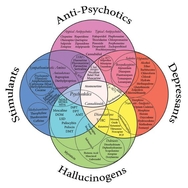FUTURE TRENDS
New Diagnoses
New Drugs
New Treatments
Welcome to the Future Treatment Eras
(1) Asylums
(2) Freudian/Psychodynamic
(3) Psychopharmacologic
(4) Molecular Neurobiology (already started)
Molecular Neurobiology Era
Study of Neurons, neurological growth, and development at the molecular level
Treatments biologically focused and more precise than pharmacology era
Future treatments may fail to treat psychological since mental/emotional aspects are unobservable
Limited approach to unobservable drives and concepts have no place in this era
Molecular Neurobiology
“Brave New Vocabulary”
Akt, astroglia, biomarkers, brain repair, connectome, dendrites, dendritic spines, dentate
gyrus, DISC1, dysbindin, epigenetics, gene knockin, gene knock-out, glia, genome-wide association, study interneurons, microglia, mirror neurons, neuregulin, neurite extension, neurocognition, neuroimaging, neuroinflammation, neurogenesis,
neurogenetics, neuroplasticity, nitrosative stress, optogenetics, oxidative stress, pluripotent cells, progenitor cells, single nucleotide polymorphisms, subventricular zone, tractography
1. Akt (Protein Kinase B)
Thought to be Associated with cellular processes like metabolizing glucose, apoptosis, cell
proliferation, transcription, and cell migration.
Akt inhibitors being investigated as treatments for cancer, HIV, and Herpes Simplex Virus
2. Dentate Gyrus
Part of hippocampus (1 of 2 interlocking gyri composing hippocampus (other is Ammon’s horn)
New neurons forms here even in adulthood
Depression, stress, high blood sugar impair it
3. DISC1 (Disrupted in Schizophrenia 1)
Protein encoded by the DISC1 gene in humans
Participates in cell proliferation, differentiation, migration, neuronal, axon, and dendrite outgrowth, mitochondrial transport, cell-to-cell adhesion
Disruption associated of this protein associated with depression, bipolar disorder, & schizophrenia
Also associated with neural plasticity
4. Neuroregulins
Cell-to-cell signaling proteins
Family of 4 related proteins
- Involved in developing Heart
- Differentiating Schwann cells from oligodendrites
- Neural development
- Neuromuscular synapses
- Linked to glutamate hypothesis of schizophrenia
5. Neurite Extension
Process by which neurons are generated from neural stem cells & progenitor cells
Form axons and dendrites
Failure to extend/grow causes problems with neuronal communication
6. Nitrosative Stress
Damage to cells and proteins due to excessive nitrogen
Body’s reaction for high NO concentration due to decreased NO
synthase
Causes transcription factors to increase or decrease DNA activity
7. Optogenetics
Procedure to observe/control neurons made sensitive to light
Allows for accurate/fast monitoring of living tissues
Treat disorders associated with neurons controlling their function
8. Oxidative Stress
Similar to nitrosative stress
Body’s reaction to buildup of oxygen
Leads to peroxides and free radicals
Drugs that stop/destroy free radicals are neurotrophic; major future market
9. Proteomics
Study of structure & function of proteins
Role proteins play in various cell types
Relevant to disorders like Alzheimers (ALZ) and schizophrenia
10. Subventricular Zone
Walls of lateral ventricles
Neurogenesis continues here into adulthood
Layers
- I: Lines lateral ventricles
- II: Possibly Neural Development
- III: Oligodendrocytes & ependymal cells = unknown function
- IV: Transition between astrocytes and parenchyma layer, contains large amounts of myelin
Computer Assisted Devices reduce our wrong diagnosing 40% of time
Epocrates.com
Tarascon.com
GeneMedRx.com
PrescribersLetter.com
Drug advertising expanded
Blurring of lines between normal and beginning of disease
- Depression expanded to include “adjustment disorders” and “premenstrual dysphoric disorder”
- Normal memory loss will become “age related memory disorder” (nootropics & promnestics)
- Grieving, now “Bereavement Disorders”
- Addictions viewed as pathology of learning and memory
- Fibromyalgia viewed as disorder on affective spectrum
- Anti-depressants go over-the-counter
Future Pharmaceuticals
Sigma Ligands, “Sigma Enigmas,” MOA unknown Example: Nuedexta®, Approved 2010
MOA: Exerts action via sigma-1 receptor agonist and NMDA receptor antagonism
(dextromethorphan)
FDA Approved: Acute treatment of Pseudobulbar Affect (PBA) – emotional lability
Lazaroids: Free-radical scavenging and membrane stabilizing
Corticotropin-Releasing Factor antagonists
Old Theories of Depression - Monoamine Revised/Down-regulation/Cortisol
New: Neurogenic Theory of Depression - Result of two new discoveries:
1. Existing neurons able to repair/remodel
2. Neurogenesis
- Involves 2nd messengers
- Protect neurons from damage
- Promote health/stability of newly formed neurons
- BDNF - Brain Derived Neurotrophic Growth Facto4
Nociceptives & Nootropics
(1) Treat pain associated with depression first
(2) Treat memory issues associated with mental illness first
